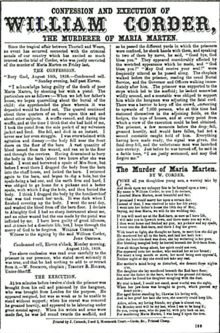Street literature

- This article is about broadside printing. For the modern literary genre, see Urban fiction.
Street literature or broadsides began in the 16th century and continued until the mid-19th century as a type of printing of large printed sheets of paper, designed to be plastered onto walls. By the mid-19th century, the advent of newspapers and inexpensive novels resulted in the demise of the street literature broadside.
In the Victorian era, broadside ballads were a popular type of broadside and were printed on thin sheets of paper and sold for a penny or half-penny in London.
Broadsides were generally folded twice to make small pamphlets or chapbooks. Collections of songs in chapbooks were known as garlands.
Broadsides pasted on walls are still used as a form of mass communication in Haredi Jewish communities, where they are known by the Yiddish term "pashkevil" (pasquil), even if they are not attacks or lampoons.[1]
See also
Notes
- ↑ Rena Rossner (December 9, 2005). "The writing on the wall". Jerusalem Post.
References
- The Word on the Street - Broadsides at the National Library of Scotland searchable online database
- University of Glasgow Broadside Collection
- Street Ballads
- Broadsided - a modern, web-distributed, on-the-streets incarnation of traditional broadsides
- Street Ballads of Victorian England
- Ashton, John. Modern Street Ballads. New Introduction by Leslie Shepard. London: Chatto & Windus, 1888. Reissued by Singing Tree Press, 1968.
- Bratton, J. S. The Victorian Popular Ballad. Totowa, New Jersey: Rowman and Littlefield, 1975 ISBN 0-87471-760-4
- Shepard, Leslie. The History of Street Literature: The Story of Broadside Ballads, Chapbooks, Proclamations, News-Sheets, Election Bills, Tracts, Pamphlets, Cocks, Catchpennies, and other Ephemera. Detroit, Michigan: Singing Tree Press, 1973. ISBN 0-7153-5881-2
- turkish street literature